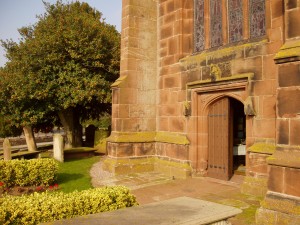In the ‘Charter of Confirmation’ in 1093 by Hugh Lupus, the 1st Earl of Chester, it is mentioned that Richard de Rullos gave the Church in Waverton as a grant to the Abbey of St. Werburghs (now Chester Cathedral). Waverton itself is listed in the Doomsday Book predating the Charter by several hundred years. It is therefore probable that an early Saxon church was built on the site of the present church between the completion of the Doomsday survey and this date. But being made of wood no physical evidence of it remains.
The church built after the Norman Conquest by Hugh Lupus and given to the Abbey in 1093 was of red sandstone from the nearby quarry. Today’s building is the result of a process of evolution over more than 900 years. There are still traces of Norman style architecture in the rude nail head ornament on the pillar at the west end of the South Aisle. The tower was erected about the time of Henry VII (1485-1509), and the roof is Elizabethan. It has timber framework with hammer beams, carried on corbels, one which is carved in the form of a Tudor rose. Two Tudor figures can be seen on the hammer beams near the east end of the nave. One beam bears the date 1635, but it is not clear to what this date actually refers.
Extensive repairs and renovations were carried out during the nineteenth century, resulting in the church we see today. They included the installation of a new west window in 1856, a new east window in 1868 and the construction of the pyramid-shape roof on top of the tower, allegedly ordered by the Duke of Westminster to enable him to clearly identify the church and hence his bearings, whilst out riding or hunting!

